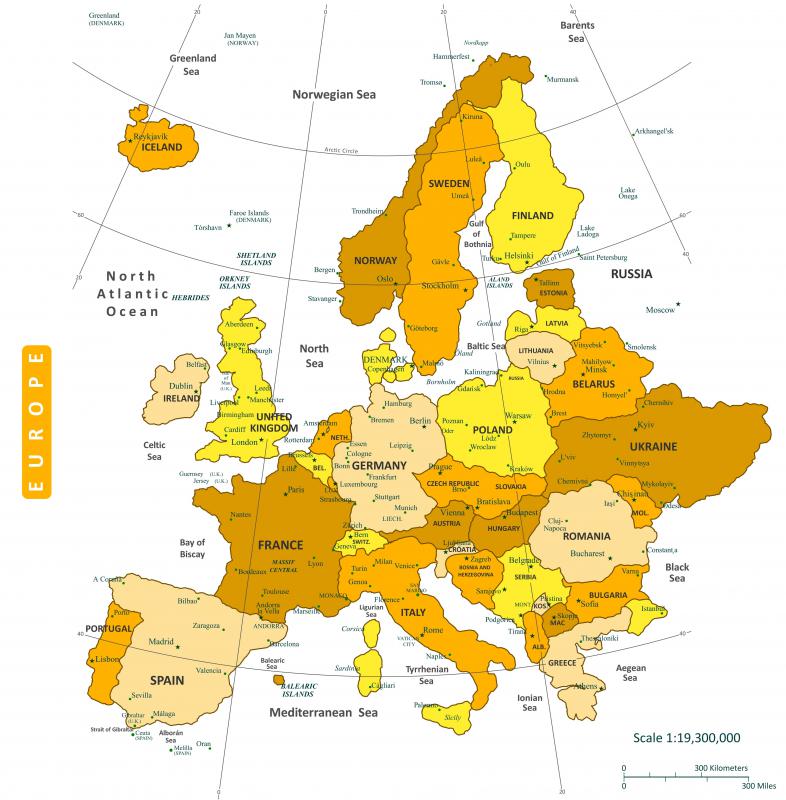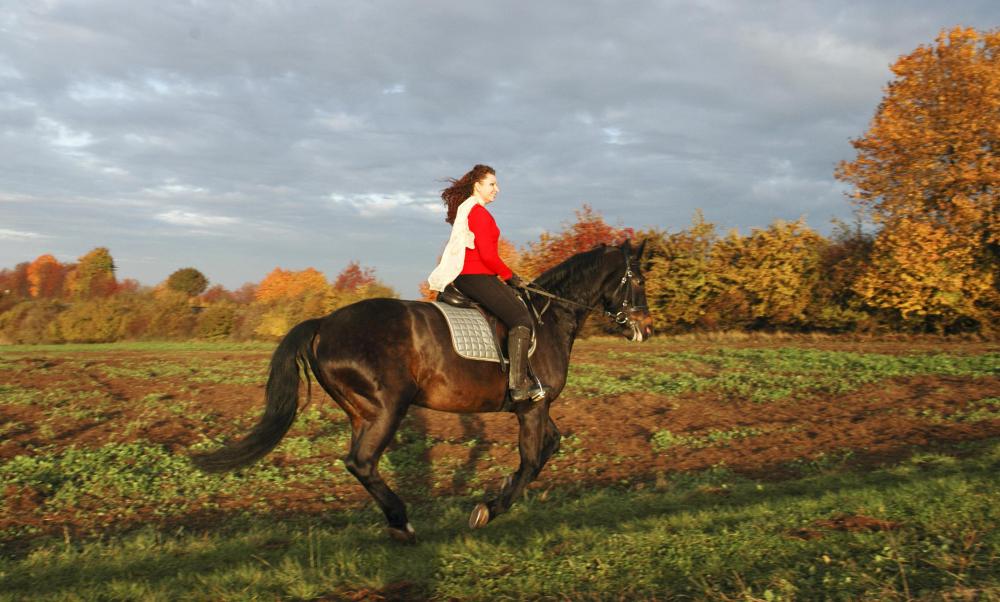At AllThingsNature, we're committed to delivering accurate, trustworthy information. Our expert-authored content is rigorously fact-checked and sourced from credible authorities. Discover how we uphold the highest standards in providing you with reliable knowledge.
What is a Warmblood Horse?
A warmblood horse is a horse with a medium build, designed for sporting. Numerous sport horses around the world are classified as warmbloods, and these horses can be seen in action in a wide range of events, from three day eventing to dressage. The term “warmblood” does not refer to a specific breed of horse, but rather to a large and general group of horses which share a number of characteristics. Some typical warmblooded breeds include the Hanoverian, Trakehner, and Westphalian.
These horses are believed to have originated in continental Europe, and they may be descended from earlier forest horses which roamed Europe and were tamed by human settlers. Some warmblood breeds are quite ancient and justifiably famous for their many talents.

Many nations, including most famously Germany and Holland, have individual warmblood registries. These studbooks welcome horses from a range of breeds as long as they meet the warmblood standard, and in fact the requirements for these studbooks are often quite stringent. As a general rule, a horse which is registered as a warmblood must be very sound, with excellent conformation and generally good health. Horses of all colors are accepted in many studbooks.

The build of the warmblood combines endurance, strength, and immense muscle control. Many warmbloods are used in dressage, taking advantage of their elegant carriage and beautiful movements in the dressage ring to perform difficult maneuvers. Others are used as jumpers, hunters, and eventers, competing in events like endurance rides to prove their mettle.

Many warmblood horses are quite large, but they have a refined conformation, lacking the heavy build of cold blooded draft horses like Clydesdales and Percherons. As a general rule, the warmblood standard also includes very calm, intelligent horses who are known for being able to perform under stress and in a wide variety of situations. Depending on the training that a horse receives, it may or may not be suitable for beginning riders, with some warmbloods demanding immense control and skill from their riders.

Many breeders around the world offer warmbloods for sale, and these horses are as a general rule very popular. As registered warmbloods can sometimes be expensive, some riders seek out horses which did not quite meet the breeding standard, but who have many of the desirable traits of the warmblood. These horses can often perform very well in the ring, and they also make good trail horses, possessing the stamina, intelligence, and dynamic action which make the warmblood so popular with riders around the world.
Frequently Asked Questions
What exactly is a Warmblood horse?
A Warmblood horse is a group of middle-weight horse breeds primarily originating from Europe. They are known for their agility, strength, and calm temperaments, making them excellent for dressage, show jumping, and eventing. Unlike Thoroughbreds (hot-bloods) or draft horses (cold-bloods), Warmbloods are bred for sport and possess a balanced mix of speed, power, and temperament.
How are Warmbloods different from other horse types?
Warmbloods differ from other horse types in their breeding purpose and physical characteristics. They are selectively bred for equestrian sports, which demands a unique combination of athleticism, conformation, and temperament. They are generally larger and more muscular than hot-bloods like Thoroughbreds but more refined and agile than cold-bloods like Clydesdales.
What are some popular breeds of Warmblood horses?
Popular Warmblood breeds include the Dutch Warmblood, Hanoverian, Oldenburg, Westphalian, and Swedish Warmblood. Each breed has its own studbook and breeding program, focusing on producing horses with the traits desired for specific equestrian disciplines. For instance, the Hanoverian is renowned for its success in dressage and show jumping.
Can Warmbloods be used for activities other than sports?
While Warmbloods are primarily bred for competitive sports, their versatile nature allows them to excel in various activities. They are often used for recreational riding, therapeutic riding programs, and even working roles on ranches or farms. Their calm demeanor and willingness to learn make them suitable for a wide range of equestrian pursuits.
What should one consider when buying a Warmblood horse?
When buying a Warmblood horse, consider the horse's lineage, training level, and health. A reputable breeder or seller should provide a detailed history of the horse's pedigree and performance. It's also crucial to have a pre-purchase veterinary exam to check for any health issues. Lastly, ensure the horse's temperament and skill level match your riding abilities and goals.
How do you care for a Warmblood horse?
Caring for a Warmblood horse involves providing a balanced diet, regular exercise, and routine veterinary care. They require a diet tailored to their activity level, including quality forage and grains. Adequate turnout and a structured exercise regimen help maintain their physical and mental health. Regular hoof care, vaccinations, and dental checkups are also essential for their well-being.
AS FEATURED ON:
AS FEATURED ON:














Discussion Comments
If you want a horse that is an all-around horse, then you should go for a Spanish horse as they are the best. They have the conformation that allows them to be the best for dressage. They are very elastic and they have an uphill motion that allows them to do all the moves in dressage without any trouble, like the Warmblood does.
The Warmblood's best movement is his extended trot, but it has trouble with the medium trot, collected trot and the piaffe, but the Spanish can do all with no trouble. The extended trot is the hardest for them, but they can still do it, and well. The Spanish has the best conformation for it because it is a naturally collected horse.
I have been to a lot of horse sales, and always perk up my ears when I hear they have a warmblood horse for sale.
My cousin lives on a working ranch, and one summer when we visited we were able to ride with him on the ranch. The horse I rode was a warmblood and I fell in love with the striking look and the stamina this horse had.
My cousin said he can ride that horse all day long and it never appears to get tired. This is a good quality to have in a horse that is worked and used often.
I have used the same country vet for 20 years and he is a horse lover. He is also a very tall man and has become involved with dressage in the last several years.
He has two warmblood horses that are tall, beautiful animals. When they hosted a dressage event at their farm a few years ago, we went and watched part of the event. Because he is so tall, the big warmblood horses were a good fit for his frame.
He went on to win two different state dressage championships with his warmblood horses. He said these were German warmblood horses that he bought from a special breeder. I am sure they cost way more than what I paid for my quarter horses, but they are big horses with great looking confirmation.
While warm blooded horses are the best choice for an all around horse, if you are interested in breeding horses, you should look at cold blooded ones as well.
Unfortunately, the popularity of warm bloods, which are more suited to modern life, has meant that many of the cold blooded breeds, like Clydesdales and Shire horses are starting to die out.
It would be a real shame, and a loss to the world, if they were allowed to do so. So, if you have the ability to make a difference there, you should definitely consider it.
I think the term warm blood might come from the fact that they are in between hot blooded horses and cold blooded horses in terms of temperament.
Hot blooded horses are usually from Arabian stock, and they tend to be fast, lithe, and flighty. They aren't the kind of horse you want for a causal ride.
While cold blooded horses are generally large breeds that were developed for pulling wagons and as war horses, and are generally very placid and powerful.
I think that many modern "warm blooded" horses came from breeding hot bloods and cold blood together in order to get a horse with more speed, that wasn't quite so flighty.
Post your comments